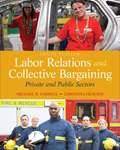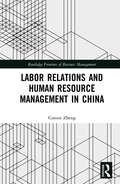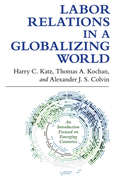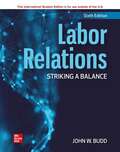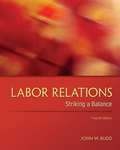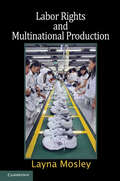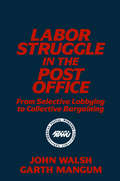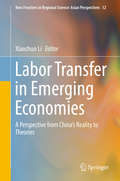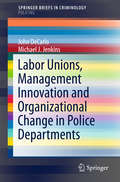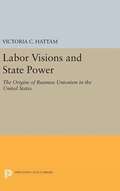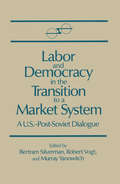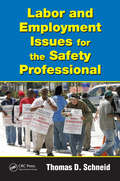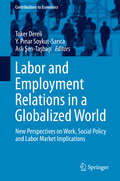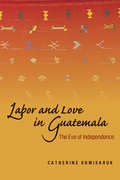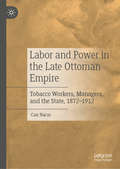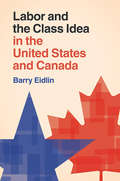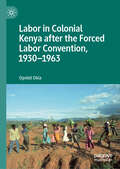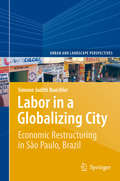- Table View
- List View
Labor Relations and Collective Bargaining: Private and Public Sectors
by Michael R. Carrell Christina HeavrinBring your best case to the table by putting theory into practice with this guide to labor relations, unions, and collective bargaining. Labor Relations and Collective Bargaining: Cases, Practice, and Law introduces readers to collective bargaining and labor relations. This text is concerned with application, as well as coverage of labor history, laws, and practices.
Labor Relations and Human Resource Management in China (Routledge Frontiers of Business Management)
by Connie ZhengThis book takes a strategic approach and provides a comprehensive review of books and papers about human resource management (HRM) and labor relations management in China, especially since China’s accession to the World Trade Organization (WTO) in 2001. In particular, the book evaluates the development of HRM under China’s changing institutional environment, particularly since President Xi Jinping has taken dominant control of the Chinese Community Party (CCP) from 2010 onwards. The book provides a historical snapshot of how HRM has been rooted in China and its rhetorical impact on China’s national economic development, continuing enterprise reform, and sustaining individual creativity and innovation. It discusses and analyzes HRM and spirituality in the context of a rising aspiration of achieving the ‘Chinese Dream’ as conceptualized by President Xi Jinping.
Labor Relations in a Globalizing World
by Thomas A. Kochan Alexander J. Colvin Harry C. KatzCompelled by the extent to which globalization has changed the nature of labor relations, Harry C. Katz, Thomas A. Kochan, and Alexander J. S. Colvin give us the first textbook to focus on the workplace outcomes of the production of goods and services in emerging countries. In Labor Relations in a Globalizing World, they draw lessons from the United States and other advanced industrial countries to provide a menu of options for management, labor, and government leaders in emerging countries. They include discussions based in countries such as China, Brazil, India, and South Africa which, given the advanced levels of economic development they have already achieved, are often described as "transitional," because the labor relations practices and procedures used in those countries are still in a state of flux.Katz, Kochan, and Colvin analyze how labor relations functions in emerging countries in a manner that is useful to practitioners, policymakers, and academics. They take account of the fact that labor relations are much more politicized in emerging countries than in advanced industrialized countries. They also address the traditional role played by state-dominated unions in emerging countries and the recent increased importance of independent unions that have emerged as alternatives. These independent unions tend to promote firm- or workplace-level collective bargaining in contrast to the more traditional top-down systems. Katz, Kochan, and Colvin explain how multinational corporations, nongovernmental organizations, and other groups that act across national borders increasingly influence work and employment outcomes.
Labor Relations: Striking A Balance
by John W. BuddBudd presents labor relations as a system for balancing employment relationship goals (efficiency, equity, and voice) and the rights of labor and management. By weaving these themes with the importance of alternative perspectives on the nature of employment relationship throughout the text, students can learn not only how the traditional labor relations processes work, but also why these processes exist and how to evaluate whether they are working. In this way, students can develop a deeper understanding of labor relations that will help them successfully navigate a contemporary labor relations system that faces severe pressures requiring new strategies, policies, and practices."
Labor Relations: Striking a Balance (Fourth Edition)
by John W. Budd<p>John Budd continues to present the most dynamic, engaging approach to understanding labor relations in the 21st century with Labor Relations, 4/e. This textbook presents labor relations as a system for balancing employment relationship goals (efficiency, equity, and voice) and the rights of labor and management. <p>By weaving these themes with the importance of alternative perspectives on the nature of the employment relationship throughout the text, students can learn not only how the traditional labor relations processes work, but also why these processes exist and how to evaluate whether they are working. In this way, students can develop a deeper understanding of labor relations that will help them successfully navigate a contemporary labor relations system that faces severe pressures requiring new strategies, policies, and practices.</p>
Labor Rights and Multinational Production
by Layna MosleyLabor Rights and Multinational Production investigates the relationship between workers' rights and multinational production. Mosley argues that some types of multinational production, embodied in directly owned foreign investment, positively affect labor rights. But other types of international production, particularly subcontracting, can engender competitive races to the bottom in labor rights. To test these claims, Mosley presents newly generated measures of collective labor rights, covering a wide range of low- and middle-income nations for the 1985–2002 period. Labor Rights and Multinational Production suggests that the consequences of economic openness for developing countries are highly dependent on foreign firms' modes of entry and, more generally, on the precise way in which each developing country engages the global economy. The book contributes to academic literature in comparative and international political economy, and to public policy debates regarding the effects of globalization.
Labor Rising
by Richard Greenwald Daniel KatzWhen Wisconsin governor Scott Walker threatened the collective bargaining rights of the state's public sector employees in early 2011, the massive protests that erupted inresponse put the labor movement back on the nation's front pages. It was a fleeting reminder of a not-so-distant past when the "labor question"-and the power of organized labor-was part and parcel of a century-long struggle for justice and equality in America.Now, on the heels of the expansive Occupy Wall Street movement and midterm election outcomes that are encouraging for the labor movement, the lessons of history are a vital handhold for the thousands of activists and citizens everywhere who sense that something has gone terribly wrong. This pithy and accessible volume provides readers with an understanding of the history that is directly relevant to the economic and political crises working people face today, and points the way to a revitalized twenty-first-century labor movement.With original contributions from leading labor historians, social critics, and activists, Labor Rising makes crucial connections between the past and present, and then looks forward, asking how we might imagine a different future for all Americans.
Labor Struggle in the Post Office: From Selective Lobbying to Collective Bargaining (Labor And Human Resources)
by John Walsh Garth L. MangumUsing data from the 2000 Census, this collection examines the major demographic and employment trends in the rural Midwestern states with special attention to the issues that state and local policy makers must address in the near future.
Labor Transfer in Emerging Economies
by Xiaochun LiBased on new phenomena appearing in many emerging economies, this book presents a theoretical study on the economic influences of labor transfer from several aspects. In recent years, thanks to the continuous progress of social forms as well as science and technology, there are a large number of new developing trends in emerging nations. Taking China as an example, several economic issues have sprung up with the huge scale of labor transfer, such as development of modern agriculture, environmental protection, privatization of mixed enterprises, training of human capital, and migrant workers' remittances to their hometowns. However, the existing researches on labor transfer pay little attention to them. In order to bridge the gap, this book combines new economic data with basic theories of labor migration, and discusses economic influences of labor transfer in four angles: human capital, migrants' remittances, environmental protection, and development of modern agriculture. Each part is composed of two or three analytical elements. Our conclusions not only enrich existing theoretical researches, but also provide theoretical support for related national economic policies.
Labor Under Fire: A History of the AFL-CIO since 1979
by Timothy J. MinchinFrom the Reagan years to the present, the labor movement has faced a profoundly hostile climate. As America's largest labor federation, the AFL-CIO was forced to reckon with severe political and economic headwinds. Yet the AFL-CIO survived, consistently fighting for programs that benefited millions of Americans, including social security, unemployment insurance, the minimum wage, and universal health care. With a membership of more than 13 million, it was also able to launch the largest labor march in American history--1981's Solidarity Day--and to play an important role in politics.In a history that spans from 1979 to the present, Timothy J. Minchin tells a sweeping, national story of how the AFL-CIO sustained itself and remained a significant voice in spite of its powerful enemies and internal constraints. Full of details, characters, and never-before-told stories drawn from unexamined, restricted, and untapped archives, as well as interviews with crucial figures involved with the organization, this book tells the definitive history of the modern AFL-CIO.
Labor Unions, Management Innovation and Organizational Change in Police Departments
by John Decarlo Michael J. JenkinsThis Brief examines the role of Police Unions in law enforcement policy development. It provides an overview of the historical and political background of police labor unions, and takes a critical look at the shifting perception of labor unions from generally positive to somewhat negative, to compare this perception with their real impact. It examines the perceived role that unions play, whether positive, negative, or neutral in the development and advancement of contemporary law enforcement agencies and their respective policies. This work provides a multisite survey of police administrators' views and opinions on police union impact on a variety of police functions including: delivery of services, prevention of crime and disorder, and interaction with the public. The results of this research provide a comprehensive look at ways to improve the ways police departments operate and how they improve and enhance legitimacy in their communities. It provides a context for the current state of the public sector labor relations environment. It will be of interest to researchers in criminology and criminal justice, police science, and public policy.
Labor Unions, Partisan Coalitions, and Market Reforms in Latin America (Cambridge Studies In Comparative Politics Series)
by Maria Victoria MurilloDue to economic crises, labor parties followed economic policies that hurt labor unions during the 1990s, such as trade liberalization and privatization. This book explains why labor unions resisted on some occasions and submitted on others and what the consequences of their actions were by studying three countries: Argentina, Mexico, and Venezuela. The comparison between the experiences of the three countries and five different sectors in each country shows the importance of politics in explaining labor reactions and their effects on economic policies.
Labor Unrest in Scranton
by Marnie Azzarelli Margo L. AzzarelliOn an August morning in 1877, a dispute over wages exploded between miners and coal company owners. A furious mob rushed down Lackawanna Avenue only to be met by a deadly hail of bullets. With its vast coal fields, mills and rail lines, Scranton became a hotbed for labor activity. Many were discontented by working endless and dangerous hours for minimal pay. The disputes mostly ended in losses for labor, but after a strike that lasted more than one hundred days, John Mitchell helped win higher wages, a shorter workday and better working conditions for coal miners. The legendary 1902 Anthracite Coal Strike Commission hearings began in Scranton, where famed lawyer Clarence Darrow championed workers' rights. Local authors Margo and Marnie Azzarelli present this dramatic history and its lasting legacy.
Labor Visions and State Power: The Origins of Business Unionism in the United States (Princeton Studies In American Politics: Historical, International, and Comparative Perspectives)
by Victoria C. HattamWhy has labor played a more limited role in national politics in the United States than it has in other advanced industrial societies? Victoria Hattam demonstrates that voluntarism, as American labor's policy was known, was the American Federation of Labor's strategic response to the structure of the American state, particularly to the influence of American courts. The AFL's strategic calculation was not universal, however. This book reveals the competing ideologies and acts of interpretation that produced these variations in state-labor relations.
Labor and Democracy in the Transition to a Market System
by Bertram Silverman Robert Vogt Murray YanovichNowhere is the tension attending simultaneous political democratization and economic liberalization more sharply felt than in the realm of labour relations. What is happening in Soviet trade unions today? How will the emerging independent unions respond to anticipated rises in unemployment? What kind of social regulation of the labour market will be appropriate in the future? These papers from a pathbreaking US-Soviet conference on labour issues reveal a considerable diversity of views on questions whose resolution will be essential to social peace in this period of transition. Among the noted contributors are Joseph Berliner, Sam Bowles, Richard Freeman, Leonid Gordon, V.L.Kosmarskii, Alla Nazimova, Michael Piore, Boris Rakitskii, Iurii Volkov, Ben Ward and Tatiana Zaslavskaia.
Labor and Employment Issues for the Safety Professional (Occupational Safety & Health Guide Series)
by Thomas D. SchneidAn examination of the safety laws and regulations, particularly in the areas of labor and employment, this book provides a working knowledge of the impacts, requirements, and implications of safety professionals' actions and inactions as related to state and federal laws. It presents information on an issue-by-issue basis and delineates the basics of the issue; identifies the applicable law or regulation; and presents possible solutions to achieve and maintain compliance while achieving the safety objective. The book covers conflicts between laws and regulations and includes case law and reference points.
Labor and Employment Relations in a Globalized World
by Toker Dereli Y. Pinar Soykut-Sarica Asli Şen-TaşbaşiThis book explores the new challenges for work and employment relations in the wake of globalization. It describes contemporary developments and ways in which labor relations systems are evolving around the world and in Turkey. Authors combine the latest information with in-depth insights on a variety of issues. The implications of international trade for employment, the dichotomy between competitiveness and meeting international labor standards, the multinationals' effects on labor relations, social policy implications of American higher education, the search for the right regulatory balance between labor flexibility and job security, challenges faced in establishing temporary work agencies, the role of skills training and providing women with micro credits to overcome informal employment problems are just some of the issues analyzed in this book. Thus, the contributions from Turkish and international institutions offer a valuable overview of the ongoing discussions in the field of labor economics and employment relations.
Labor and Love in Guatemala: The Eve of Independence
by Catherine KomisarukLabor and Love in Guatemalare-envisions the histories of labor and ethnic formation in Spanish America. Taking cues from gender studies and the "new" cultural history, the book transforms perspectives on the major social trends that emerged across Spain's American colonies: populations from three continents mingled; native people and Africans became increasingly hispanized; slavery and other forms of labor coercion receded. Komisaruk's analysis shows how these developments were rooted in gendered structures of work, migration, family, and reproduction. The engrossing narrative reconstructs Afro-Guatemalan family histories through slavery and freedom, and tells stories of native working women and men based on their own words. The book takes us into the heart of sweeping historical processes as it depicts the migrations that linked countryside to city, the sweat and filth of domestic labor, the rise of female-headed households, and love as it was actually practiced—amidst remarkable permissiveness by both individuals and the state.
Labor and Power in the Late Ottoman Empire: Tobacco Workers, Managers, and the State, 1872–1912
by Can NacarBy the early twentieth century, consumers around the world had developed a taste for Ottoman-grown tobacco. Employing tens of thousands of workers, the Ottoman tobacco industry flourished in the decades between the 1870s to the First Balkan War—and it became the locus of many of the most active labor struggles across the empire. Can Nacar delves into the lives of these workers and their fight for better working conditions. Full of insight into the changing relations of power between capital and labor in the Ottoman Empire and the role played by state actors in these relations, this book also draws on a rich array of primary sources to foreground the voices of tobacco workers themselves.
Labor and Punishment: Work in and out of Prison
by Erin HattonThe insightful chapters in this volume reveal the multiple and multifaceted intersections between mass incarceration and neoliberal precarity. Both mass incarceration and the criminal justice system are profoundly implicated in the production and reproduction of the low-wage "exploitable" precariat, both within and beyond prison walls. The carceral state is a regime of labor discipline—and a growing one—that extends far beyond its own inmate labor. This regime not only molds inmates into compliant workers willing and expected to accept any "bad" job upon release but also compels many Americans to work in such jobs under threat of incarceration, all the while bolstering their "exploitability" and socioeconomic marginality. Contributors include Anne Bonds, Philip Goodman, Amanda Bell Hughett, Caroline M. Parker, Gretchen Purser, Jacqueline Stevens, and Noah D. Zatz.
Labor and the Chinese Revolution: Class Strategies and Contradictions of Chinese Communism, 1928–1948 (Michigan Monographs In Chinese Studies #49)
by S. Bernard ThomasIn the two-decade period from 1928 to 1948, the proletarian themes and issues underlying the Chinese Communist Party’s ideological utterances were shrouded in rhetoric designed, perhaps, as much to disguise as to chart actual class strategies. Rhetoric notwithstanding, a careful analysis of such pronouncements is vitally important in following and evaluating the party’s changing lines during this key revolutionary period. The function of the “proletariat” in the complex of policy issues and leadership struggles which developed under the precarious circumstances of those years had an importance out of all proportion to labor’s relatively minor role in the post-1927 Communist led revolution. [1, 2]
Labor and the Class Idea in the United States and Canada (Cambridge Studies In Contentious Politics )
by Barry EidlinWhy are unions weaker in the US than in Canada, two otherwise similar countries? <P><P>This difference has shaped politics, policy, and levels of inequality. Conventional wisdom points to differences in political cultures, party systems, and labor laws. But Barry Eidlin's systematic analysis of archival and statistical data shows the limits of conventional wisdom, and presents a novel explanation for the cross-border difference. <P>He shows that it resulted from different ruling party responses to worker upsurge during the Great Depression and World War II. Paradoxically, US labor's long-term decline resulted from what was initially a more pro-labor ruling party response, while Canadian labor's relative long-term strength resulted from a more hostile ruling party response. These struggles embedded 'the class idea' more deeply in policies, institutions, and practices than in the US. In an age of growing economic inequality and broken systems of political representation, Eidlin's analysis offers insight for those seeking to understand these trends, as well as those seeking to change them.<P> Provides a novel theory of American exceptionalism.<P> Presents the most comprehensive and systematic assessment ever of explanations for US union decline.<P> Written in an accessible style, with carefully explained graphs using only descriptive statistics.
Labor in Colonial Kenya after the Forced Labor Convention, 1930–1963
by Opolot OkiaThis book advances research into the government-forced labor used widely in colonial Kenya from 1930 to 1963 after the passage of the International Labor Organization’s Forced Labour Convention. While the 1930 Convention intended to mark the suppression of forced labor practices, various exemptions meant that many coercive labor practices continued in colonial territories. Focusing on East Africa and the Kenya Colony, this book shows how the colonial administration was able to exploit the exemption clause for communal labor, thus ensuring the mobilization of African labor for infrastructure development. As an exemption, communal labor was not defined as forced labor but instead justified as a continuation of traditional African and community labor practices. Despite this ideological justification, the book shows that communal labor was indeed an intensification of coercive labor practices and one that penalized Africans for non-compliance with fines or imprisonment. The use of forced labor before and after the passage of the Convention is examined, with a focus on its use during World War II as well as in efforts to combat soil erosion in the rural African reserve areas in Kenya. The exploitation of female labor, the Mau Mau war of the 1950s, civilian protests, and the regeneration of communal labor as harambee after independence are also discussed.
Labor in Israel: Beyond Nationalism and Neoliberalism
by Jonathan PremingerUsing a comprehensive analysis of the wave of organizing that swept the country starting in 2007, Labor in Israel investigates the changing political status of organized labor in the context of changes to Israel’s political economy, including liberalization, the rise of non-union labor organizations, the influx of migrant labor, and Israel’s complex relations with the Palestinians. Through his discussion of organized labor’s relationship to the political community and its nationalist political role, Preminger demonstrates that organized labor has lost the powerful status it enjoyed for much of Israel’s history. Despite the weakening of trade unions and the Histadrut, however, he shows the ways in which the fragmentation of labor representation has created opportunities for those previously excluded from the labor movement regime.Organized labor is now trying to renegotiate its place in contemporary Israel, a society that no longer accepts labor’s longstanding claim to be the representative of the people. As such, Preminger concludes that organized labor in Israel is in a transitional and unsettled phase in which new marginal initiatives, new organizations, and new alliances that have blurred the boundaries of the sphere of labor have not yet consolidated into clear structures of representation or accepted patterns of political interaction.
Labor in a Globalizing City
by Simone Judith BuechlerThe extraordinary stories of low-income women living in São Paulo, industrial case studies and the details of three squatter settlements, and communities in the periphery researched in Simone Buechler's book, Labor in a Globalizing City, allow us to better understand the period of economic transformation in São Paulo from 1996 to 2003. Buechler's in-depth ethnographic research over a period of 17 years include interviews with a variety of social actors ranging from favela inhabitants to Wall Street bankers. Buechler examines the paradox of a globalizing city with highly developed financial, service, and industrial sectors, but at the same time a growing sector of microenterprises, degraded labor, considerable unemployment, unprecedented inequality, and precarious infrastructure in its low-income communities. The author argues that informalization and low-income women's labor are an integral part of the global economy. Other countries are continuing to use the same kind of neo-liberal economic model even though once again with the latest global financial crisis, it has proven to be detrimental to many workers.
